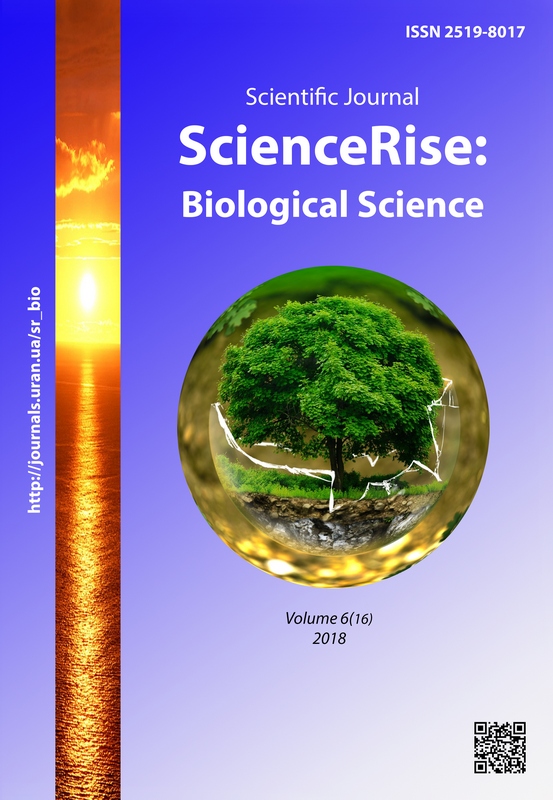Investigation of fungicidal activity of nanoparticles ZnO, TiO2 AND Ag0 of different size
DOI:
https://doi.org/10.15587/2519-8025.2018.153950Keywords:
fungicidal activity, fungicidal effectiveness, nanoparticles of metals, colloidal solution, surfactantsAbstract
The paper presents studies on the determination of fungicidal properties of colloidal solutions of various sizes of ZnO, TiO2 and Ag0 nanoparticles.
The aim of the study was to determine the effect of ZnO, TiO2 and Ag0 nanoparticles on their fungicidal activity.
Materials and methods. In order to achieve this goal in the article, studies were conducted to determine the fungicidal activity of different sizes of ZnO, TiO2 and Ag0 nanoparticles. Also, the percentage of fungicidal effectiveness of using colloidal solutions of nanowires ZnO, TiO2 and Ag0 of various sizes is estimated.
Fungicidal properties of nanosolutions were evaluated in the form of fungicidal activity and fungicidal efficacy. Fungicidal activity and fungicidal efficacy of colloidal solutions were investigated by the visual evaluation method for mold fungi of the genus Aspergillus (black mold or dark gray mold) and fungi of genus Penicillium (blue-green mold) that form colonies on rye-wheat bread.
Results. A correlation between sizes of nanoparticles of ZnO, TiO2 and Ag0 and their fungicidal action has been established. For the study, the prepared aqueous solutions of ZnO and TiO2 nanoparticles at a concentration of 0.5% were 25 nm, 35 nm, 50 nm, and solutions of Ag0 nanoparticles were prepared using OS-20 surfactant and sodium citrate precursor, the sizes of synthesized nanoparticles were 35 nm and 50 nm, the concentration of solutions of nanoparticles Ag0 was 0.5%. The high fungicidal activity was demonstrated by colloid solutions of nanosilver with particles sizes as 50 nm, contained sodium citrate solution, 2 points, contained OS-20 surfactant solution– 3 points.
Conclusion. As a result of the studies, a correlation was found between the size of the nanoparticles and their fungicidal activity, so that smaller particles of TiO2 exhibit greater fungicidal activity. ZnO and Ag nanoparticles have more pronounced fungicidal properties in larger sizesReferences
- Chekman, I. S. (2008). Nanoparticles: Properties and prospects of use. Ukrainian biochemical journal, 81, 122–129. Available at: https://www.ncbi.nlm.nih.gov/pubmed/19877425
- Golyishin, N. M. (1993). Fungitsidyi [Fungi]. Moscow: Kolos, 319.
- Asanova, A. A., Polonskiy, V. I., Manukovskiy, N. S., Hizhnyak, S. V. (2018). Fungistaticheskaya aktivnost tehnogennyih nanochastits [Fungistatic activity of man-made nanoparticles]. Russian Nanotechnologies, 13 (5-6), 62–66. Available at: https://nanorf.elpub.ru/jour/article/download/119/81
- Ayatollahi Mousavi, S. A., Salari, S., Hadizadeh, S. (2016). Evaluation of Antifungal Effect of Silver Nanoparticles Against Microsporum canis, Trichophyton mentagrophytes and Microsporum gypseum. Iranian Journal of Biotechnology, 13 (4), 38–42. doi: http://doi.org/10.15171/ijb.1302
- Kim, K-J., Sung, W. (2008). Antifungal effect of silver nanoparticles on dermatophytes. Journal of Microbiology and Biotecnology, 18 (8), 1482–1484.
- Fedorets, I. D., Hlapova, N. P., Dikiy, N. P., Dovbnya, A. N., Medvedeva, E. P. et. al. (2010). Struktura i svoystva gamma-aktivirovannyih nanochastits oksida tsinka [Structure and properties of gamma activated nanoparticles of zinc oxide]. The Journal of Kharkiv National University, 916 (3 (47)), 100–104.
- Jones, N., Ray, B., Ranjit, K. T., Manna, A. C. (2008). Antibacterial activity of ZnO nanoparticle suspensions on a broad spectrum of microorganisms. FEMS Microbiology Letters, 279 (1), 71–76. doi: http://doi.org/10.1111/j.1574-6968.2007.01012.x
- Priyanka, K. P., Harikumar, V., Balakrishna, K. M., Varghese, T. (2016). Inhibitory effect of TiO2 nanoparticles on symbiotic Arbuscular Mycorrhizal fungi in plant roots. IET Nanobiotechnology, 11 (1), 1–6. doi: http://doi.org/10.1049/iet-nbt.2016.0032
- Li, Q., Mahendra, S., Lyon, D. Y., Brunet, L., Liga, M. V., Li, D., Alvarez, P. J. J. (2008). Antimicrobial nanomaterials for water disinfection and microbial control: Potential applications and implications. Water Research, 42 (18), 4591–4602. doi: http://doi.org/10.1016/j.watres.2008.08.015
- Dudka, I. A., Vasser, S. P., Ellanskaya, I. A. (1982). Metodyi eksperimentalnoy mikologii [Methods of experimental mycology]. Kyiv: Naukova dumka, 254.
- Bilay, V. I., Koval, E. Z. (1988). Aspergilyi. Opredelitel [Aspergilas. Determinant]. Kyiv: Naukova dumka, 204.
- Samson, R. A., Hoekstra, E. S., Gens, C. (2004). Introduction to Food and Aairborne fungi. Seven edition. Frisvad, 385.
Downloads
Published
How to Cite
Issue
Section
License
Copyright (c) 2019 Maria Pasichnyk

This work is licensed under a Creative Commons Attribution 4.0 International License.
Our journal abides by the Creative Commons CC BY copyright rights and permissions for open access journals.
Authors, who are published in this journal, agree to the following conditions:
1. The authors reserve the right to authorship of the work and pass the first publication right of this work to the journal under the terms of a Creative Commons CC BY, which allows others to freely distribute the published research with the obligatory reference to the authors of the original work and the first publication of the work in this journal.
2. The authors have the right to conclude separate supplement agreements that relate to non-exclusive work distribution in the form in which it has been published by the journal (for example, to upload the work to the online storage of the journal or publish it as part of a monograph), provided that the reference to the first publication of the work in this journal is included.









